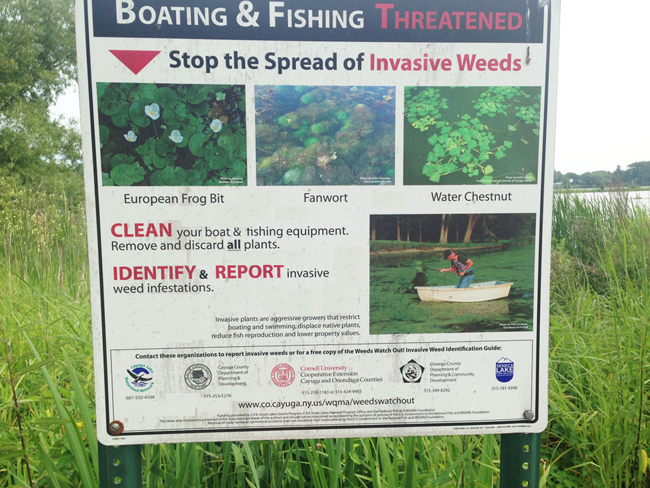By New York Sea Grant Launch Steward Ryan Thompson
New York Sea Grant 2013 Launch Stewards Program
Contacts:
Mary Penney, NY Sea Grant, E:
mp357@cornell.edu, P:315-312-3042
Kara Lynn Dunn, Publicist, E:
karalynn@gisco.net, P: 315-465-7578
Oswego, NY, August 15, 2013 - An Aquatic Invasive Species (AIS) is an organism introduced to an ecosystem that disrupts the native habitats of the region. These organisms are spread a number of ways including accidental dispersal by humans. AIS are becoming a persistent problem for waterways in New York State (NYS), clogging boating channels, disrupting the natural food webs, and impacting taxpayers.
The impacts of AIS on local economies include AIS management costs, and the potential to decrease shoreline property value.

This sign along Lake Ontario encourages boaters and anglers to
help stop the spread of aquatic invasive species;
Photo: NYSG Launch
Steward Heather Dunham
According to a study by the Anderson Economic Group, AIS have a huge economic impact on the Great Lakes region. The study states that it is “likely that the overall aggregate level of cost (to industry, consumers, and government) to the Great Lakes region is significantly over $100 million annually.”
The economic weight of AIS has been felt locally. In 2011, Hydrilla, an aquatic invasive plant, was discovered in the Cayuga Lake inlet in Ithaca, NY. Hydrilla posed three main problems to the economy of the surrounding area: hindering boating experiences, compromising flood control measures, and lowering property tax revenues.
Efforts to suppress the waterweed have proved to be effective, yet costly. James Balyszak, project manager of the Hydrilla Task Force of the Cayuga Lake Watershed, states that the project is currently in year three of a ten-year plan and estimates the expenses of the Hydrilla removal project at $400,000 for 2012. Balyszak expects the cost to remain in the $400,000 to $500,000 range per year for the remainder of the project.
AIS can adversely affect recreational activities, such as boating, fishing, swimming; lower the overall aesthetics of a property; and have the potential to decrease shoreline property value.
There is no definitive estimate for the impact AIS have on property values, however, heavy growth of aquatic weeds, including AIS, can decrease shoreline property values by up to 20 percent, says Invasive Species Specialist Chuck O’Neill with Cornell University Cooperative Extension, Ithaca, NY. O’Neill stresses that “even a 10 percent drop in waterfront property values can be a big hit to a local community.”
Suppressing AIS to maintain water and habitat quality is tough work. NYS residents can watch for opportunities to participate in local citizen programs, such as water chestnut pulls. Educational outreach programs, such as the New York Sea Grant Launch Stewards Program, are a valuable source of information about AIS, prevention measures, and management efforts for coastal residents, boaters, anglers, municipality leaders, and service groups.
Shoreline property owners and recreational users can be proactive in protecting their own property from AIS and the associated costs. To help in the effort to reduce the impacts of AIS on private property and public recreational areas, report any new AIS plant or animal to your local Partnership for Regional Invasive Species Management (PRISM) coordinators; find offices via www.nyis.info.
Those who fish, boat, kayak and canoe are advised to inspect their watercraft and equipment after every use and properly discard any aquatic hitchhiking organisms or debris or collect a specimen for identification by
iMapInvasives and/or local PRISM experts.
Help nip AIS in the bud before they nip us in the pocketbook.
For more information on protecting native habitats against invasive threats, contact New York Sea Grant at 315-312-3042,
SGOswego@cornell.edu.
To learn more about the NYSG Launch Steward Program, visit:
nysglaunchsteward.blogspot.com.
This is the fourth in a series of articles by the New York Sea Grant Launch Stewards. The stewards are college students helping to educate water users about how they can help slow the spread of aquatic invasive species as part of a statewide effort. Learn more online at
www.nyseagrant.org/ccd.
More Info:
New York Sea Grant (NYSG), a cooperative program of Cornell University
and the State University of New York, is one of 33 university-based
programs under the National Sea Grant College Program (NSGCP) of the
National Oceanic and Atmospheric Administration (NOAA). The NSGCP
engages this network of the nation’s top universities in conducting
scientific research, education, training and extension projects designed
to foster science-based decisions about the use and conservation of our
aquatic resources. Through its statewide network of integrated
services, NYSG has been promoting coastal vitality, environmental
sustainability, and citizen awareness about the State’s marine and Great
Lakes resources since 1971.
For updates on Sea Grant activities:
www.nyseagrant.org has RSS,
Facebook,
Twitter, and
YouTube links. NYSG also offers a free e-list sign up via
www.nyseagrant.org/coastlines for NY Coastlines, its flagship publication, and Currents, its e-newsletter supplement, each distributed several times a year.